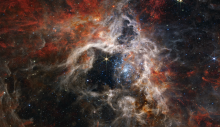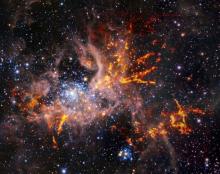Listen to today's episode of StarDate on the web the same day it airs in high-quality streaming audio without any extra ads or announcements. Choose a $8 one-month pass, or listen every day for a year for just $30.
You are here
Moon and Mars
Thousands of weather stations dot our planet’s landscape. They tell us what conditions are like at locations from the south pole to the Nile.
Earth isn’t the only planet with weather stations, though. Two of them are operating on Mars. One is on the Curiosity rover, which has been exploring the Red Planet for almost seven years. The other is on InSight, which landed on Mars late last year. Their observations help scientists understand the Martian climate.
Curiosity and InSight are only a couple of hundred miles apart, so conditions at the two sites are similar. InSight is just north of the equator, with Curiosity just south of it.
The readings mainly tell us that it’s cold on Mars. Daytime temperatures don’t climb above the single digits during winter, although they can rise above freezing during summer. And at night, they drop to a hundred below or colder, regardless of the season.
Winds tend to be moderate, but gusts can top 30 miles per hour. And if a dust devil sweeps by, the gusts can be even stronger.
A few clouds drift through the sky. There’s no rain or snow from them, though -- any precipitation would vaporize long before reaching the surface.
So the weather report from Mars is always about the same: cold, gusty, and dry.
Look for Mars to the lower right of the Moon shortly after sunset tonight. It looks like a moderately bright star. The much brighter planet Mercury is farther along the same line, just above the horizon.
Script by Damond Benningfield





